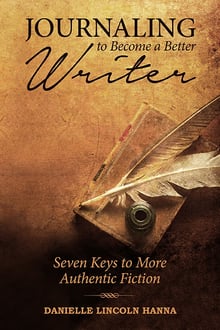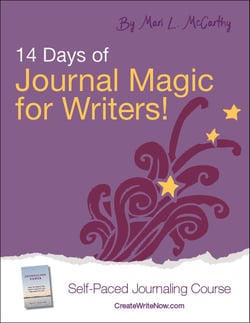by Danielle Lincoln Hanna
 At some point in my early teens, I heard it said that good writers keep journals. At the time, I wasn’t sure how jotting down events from my boring little life could possibly affect my ability to pen a novel. But since I was already keeping a journal anyway, I filed the tidbit away in the back of my mind and waited to see if journaling would contribute anything besides word count.
At some point in my early teens, I heard it said that good writers keep journals. At the time, I wasn’t sure how jotting down events from my boring little life could possibly affect my ability to pen a novel. But since I was already keeping a journal anyway, I filed the tidbit away in the back of my mind and waited to see if journaling would contribute anything besides word count.
A couple of decades and more than a million words later, I now credit my journal as one of the primary tools that helped me become a better writer.
I’m sure you’re familiar with the image of the artist in the park, sketchpad on her knee and pencil in hand. If you looked over her shoulder, you might see the duck pond recreated on paper. Or the old man on the park bench. Or the flower growing out of the crack in the sidewalk.
What’s this artist doing?
She’s sketching from life models.
But why do you see that artist in the park? Or the classroom of artists pouring their heart and soul into the fruit bowl on their teacher’s desk? Why do even the best artists use models to pose for their artwork?
Because it’s really, really hard to transfer an idea straight from thin air to the canvas unless you thoroughly understand what it looks like. You may think you know what it looks like. But as I discover (repeatedly) with my personal colored pencil set … I really have no clue what the image in my head looks like.
What if we writers had the opportunity to sketch from life models?
We do. As a writer, your journal is your sketchpad. The events of your life and the people you interact with are your life models. And you will journal about them for the same reasons an artist sketches in the park:
- To improve your eye for detail
- To strengthen your writing’s accuracy and authenticity
- To recognize story-worthy material in the real world.
If you want to bring your fiction to life, there is no better way than to “sketch from life models,” using your journal as your sketch pad. Why not give these journaling prompts a try and see what I mean?
- Grab your journal and go to your favorite coffee shop, bookstore, zoo – whatever. (In fact, never leave your house without a journal.) Then take some time to actually sit down and write about everything you see, hear, touch, feel, and taste. Go ahead. See if it doesn’t open whole new worlds to you as a journal keeper and a writer.
- Curl up with your journal in your favorite writing space. Think about a recent experience that was very emotional. Retell what happened, taking time to explore your feelings in detail. Do you have a story character with a parallel experience? Journal about how your personal experience can inform how you’ll write your character. Then – of course – go write the character’s story!
On some level, all stories are “based on a true story.” Often times, they are YOUR story. So go sketch from life models. See if it doesn’t add a whole new layer to your novel-in-progress.
 Danielle Lincoln Hanna learned how to read and write at age four and has been keeping a journal since she was five. She is the author of Journaling to Become a Better Writer: Seven Keys to More Authentic Fiction. When she’s not camping, hiking, and biking with her dog Molly, she can be found penning her “Hearth & Homicide Suspense,” a blend of crime fiction meets Thomas Kinkade. Her newsletter is available at www.DanielleLincolnHanna.com/newsletter.
Danielle Lincoln Hanna learned how to read and write at age four and has been keeping a journal since she was five. She is the author of Journaling to Become a Better Writer: Seven Keys to More Authentic Fiction. When she’s not camping, hiking, and biking with her dog Molly, she can be found penning her “Hearth & Homicide Suspense,” a blend of crime fiction meets Thomas Kinkade. Her newsletter is available at www.DanielleLincolnHanna.com/newsletter.
Website:
http://www.daniellelincolnhanna.com/
Twitter:
http://www.com/DanielleLHanna/
Pinterest:
http://www.pinterest.com/HearthnHomicide/
If you want to learn how journaling can help you tackle life's challenges such as becoming a better writer, please download the free eBook, The Journaling Guide to Manage The Stress and Strains of Life.
Journaling offers a special kind of magic for writers. Our 14 Days of Journal Magic for Writers self-paced journaling course uses daily prompts and instruction to help you hone and strengthen your craft.



Leave Comment